
Human values in the loop Design principles for ethical AI
32 minute read
28 January 2020
 Jim Guszcza United States
Jim Guszcza United States Michelle Lee United States
Michelle Lee United States Beena Ammanath United States
Beena Ammanath United States Dave Kuder United States
Dave Kuder United States
Organizations are increasingly considering the processes, guidelines, and governance structures needed to achieve trustworthy AI. Here are some underlying first principles that can guide leaders when thinking about AI’s ethical ramifications.
“This has to be a human system we live in.”–Sandy Pentland1
More than 60 years after the discipline’s birth,2 artificial intelligence (AI) has emerged as a preeminent issue in business, public affairs, science, health, and education. Algorithms are being developed to help pilot cars, guide weapons, perform tedious or dangerous work, engage in conversations, recommend products, improve collaboration, and make consequential decisions in areas such as jurisprudence, lending, medicine, university admissions, and hiring. But while the technologies enabling AI have been rapidly advancing, the societal impacts are only beginning to be fathomed.
Learn more
Explore the AI & cognitive technologies collection
This article is featured in Deloitte Review, issue 26
Download the issue
Learn about Deloitte’s services
Go straight to smart. Get the Deloitte Insights app
Until recently, it seemed fashionable to hold that societal values must conform to technology’s natural evolution—that technology should shape, rather than be shaped by, social norms and expectations. For example, Stewart Brand declared in 1984 that “information wants to be free.”3 In 1999, a Silicon Valley executive told a group of reporters, “You have zero privacy … get over it.”4 In 2010, Wired magazine cofounder Kevin Kelly published a book entitled What Technology Wants.5 “Move fast and break things” has been a common Silicon Valley mantra.6
But this orthodoxy has been undermined in the wake of an ever-expanding catalog of ethically fraught issues involving technology. While AI is not the only type of technology involved, it has tended to attract the lion’s share of discussion about the ethical implications.
Many concerns about AI-enabled technologies have been well-publicized. To cite a few: AI algorithms embedded in digital and social media technologies can reinforce societal biases, accelerate the spread of rumors and disinformation, amplify echo chambers of public opinion, hijack our attention, and impair mental well-being.7 Experts warn of AI technologies being weaponized. Semiautonomous vehicles have been reported to fail in ways the owners did not expect.8 And while fears of “smart” technologies stealing human jobs are often overstated, respected economists highlight growing inequality and lack of opportunity for certain workforce segments due to technology-induced workplace changes.9
Thanks in part to concerns like these, there have been increasing calls for AI to be designed and adopted in ways that reflect important cultural values. In a recent editorial, the investor Stephen Schwarzman urged companies to take the lead in addressing ethical concerns surrounding AI. He comments, “If we want to realize AI’s incredible potential, we must also advance AI in a way that increases the public’s confidence that AI benefits society. We must have a framework for addressing the impacts and the ethics.”10
And indeed, a large number of AI ethics frameworks have appeared in recent years. For example, a team at the Swiss university ETH Zurich recently analyzed no fewer than 84 AI ethics declarations from a variety of companies, government agencies, universities, nongovernmental organizations, and other organizations.11 While the team identified some inconsistencies, there is also reassuring overlap in the broad principles articulated. In another such effort, the AI4People group led by Luciano Floridi analyzed six high-profile AI ethics declarations. They concluded that a set of four abiding, higher-level ethical principles—beneficence, non-maleficence, justice, and autonomy—captured much of these six declarations’ essence.
These four principles are rooted in major schools of ethical philosophy and, in fact, have been widely embraced in the field of bioethics for several decades.12 It is perhaps unsurprising that they adapt well to the AI context. Writing for Harvard Data Science Review, Floridi and coauthor Josh Cowls note: “Of all areas of applied ethics, bioethics is the one that most closely resembles digital ethics in dealing ecologically with new forms of agents, patients, and environments.”13
In his book Bit by Bit, the prominent computational social scientist Matthew Salganik has recently advocated the same core principles to help data scientists evaluate the ethical implications of working with human-generated behavioral data. Salganik comments: “In some cases, the principles-based approach leads to clear, actionable solutions. And when it does not, it clarifies the tradeoffs involved, which is critical for striking an appropriate balance. Further, the principles-based approach is sufficiently general that it will be helpful no matter where you work.”14
This essay attempts to illustrate that ethical principles can serve as design principles for organizations seeking to deploy innovative AI technologies that are economically profitable as well as beneficial, fair, and autonomy-preserving for people and societies. Specifically, we propose impact, justice, and autonomy as three core principles that can usefully guide discussions around AI’s ethical implications.
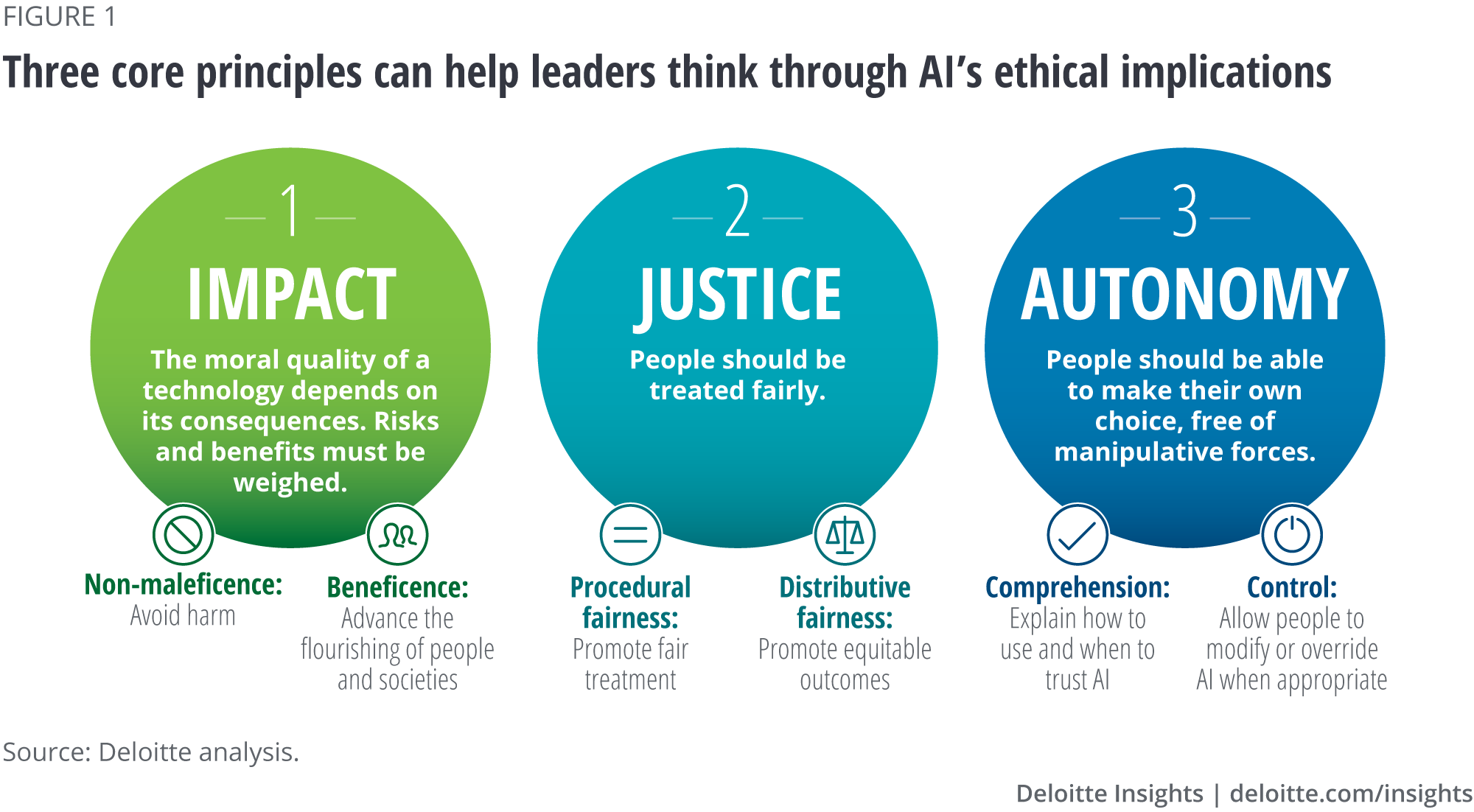
Achieving ethical, trustworthy, and profitable AI requires that ethics deliberations be grounded in a scientific understanding of the relative strengths and weaknesses of both machine intelligence and human cognition. In short, being “wise” about AI presupposes being “smart” about AI. For example, discussing ways to promote safe and reliable AI requires understanding why AI technologies—often created using forms of large-scale statistical analysis such as deep learning—succeed in some contexts but fail in others. Likewise, discussions of algorithmic fairness should be informed by both an appreciation of the biases and “noise” that affect unaided human decisions, and an understanding of the tradeoffs involved in different conceptions of algorithmic “fairness.” In each case, ethical deliberations are more productive when informed by the relevant science.
At the same time, this essay does not prescribe how to apply the core principles. Organizations differ in their goals and operating contexts, and will therefore adopt different declarations, frameworks, rule sets, and checklists to help guide the responsible development of AI technologies. Furthermore, applying fundamental principles to specific problems often requires evaluating tradeoffs between alternatives whose perceived relative importance varies across individuals, organizations, and societies. We suggest that a grasp of core principles can help individuals and organizations more effectively create ethical frameworks and deliberate specific issues.
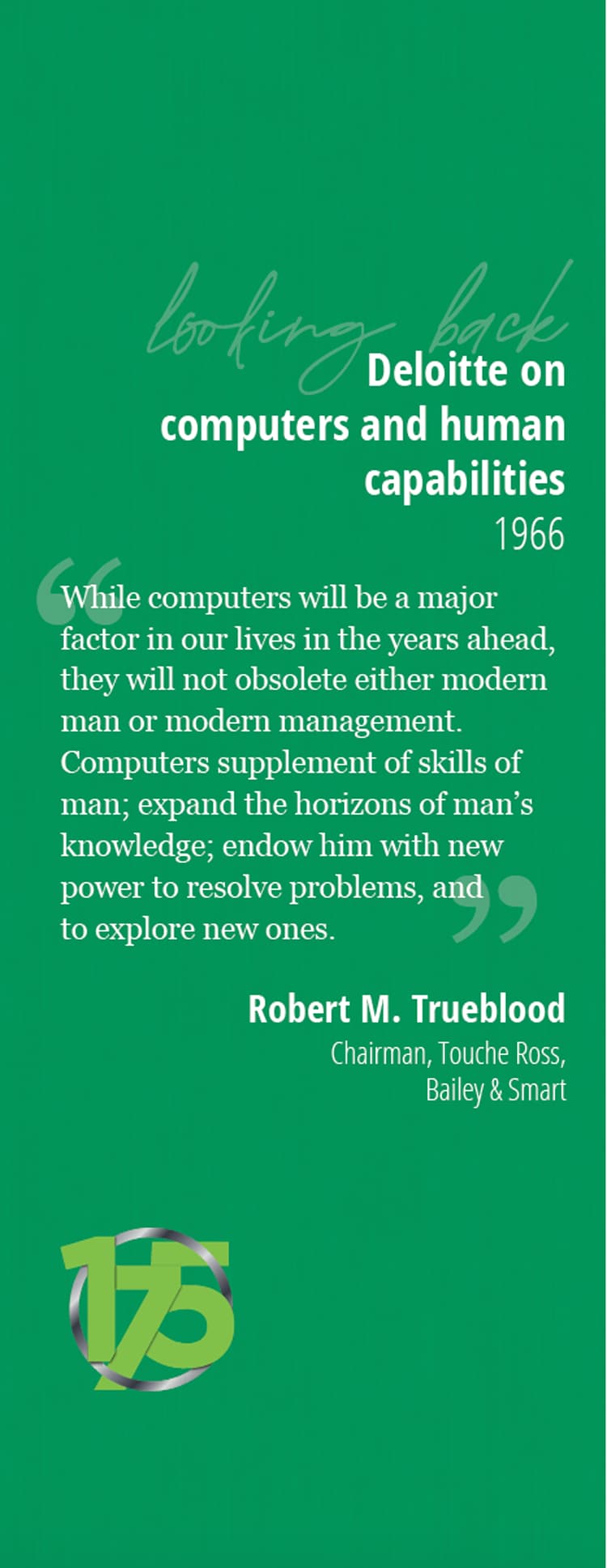
Impact: Promoting acceptable outcomes
Two widely recognized ethical principles are non-maleficence (“do no harm”) and beneficence (“do only good”). These principles are grounded in “consequentialist” ethical theory, whose proponents have included John Stuart Mill and Jeremy Bentham, and which holds that the moral quality of an action depends on its consequences.15
“First, do no harm”
Non-maleficence prescribes that AI should avoid causing both foreseeable and unintentional harm. Examples of the former could include weaponized AI,16 the use of AI in cyberwarfare, malicious hacking, the creation or dissemination of phony news or images to disrupt elections, and scams involving phishing and fraud. But of course, the great majority of organizations building or deploying AI have no intention of causing needless harm. For them, avoiding unintended consequences is the paramount concern.
Avoiding harmful AI requires that one understand AI technologies’ scientific limitations in order to manage the attendant risks. For example, many AI algorithms are created by applying machine learning techniques, most prominently deep learning, to large bodies of “labeled” data.17 The resulting algorithms can then be deployed to make predictions about future cases for which the true values are unknown. Such algorithms are used today to estimate the likelihood that a borrower will repay a loan, a student’s expected grade point average if admitted to a university, the odds that an X-ray image is a cancerous tumor, or the chances that the red object in front of a car is a stop sign.

The “artificial intelligence” moniker notwithstanding, however, these algorithms are not based on the sorts of conceptual understanding characteristic of human intelligence.18 Rather, they are the product of statistical pattern-matching. Therefore, if automatic techniques or naïve statistical methodologies are used to train algorithms on data that contain inaccuracies or biases, those algorithms themselves might well reflect those inaccuracies or biases. This basic truth of machine learning has a key ethical implication: A machine learning algorithm is only safe and reliable to the extent that it is trained on (1) sufficient volumes of data that (2) are suitably representative of the scenarios in which the algorithm is to be deployed.
A case study discussed by the prominent machine learning researcher Michael I. Jordan illustrates how a failure to appreciate such risks can lead to physical harm. In this case, an AI device was designed to estimate the likelihood of a fetus having Down syndrome based on ultrasound images. At a certain point, the input data’s format, the resolution of the ultrasound images, changed: The AI began processing higher-resolution images to compute its estimates. This change resulted in a significant uptick in the machine’s Down syndrome diagnoses. This uptick was due not to previously unrecognized cases, but to the images’ higher resolution producing spurious statistical artifacts which the algorithm (trained on lower-resolution images) misinterpreted as Down syndrome indicators. It is likely that thousands of people opted for amniocentesis procedures, putting their babies at risk, based on these faulty diagnoses.19
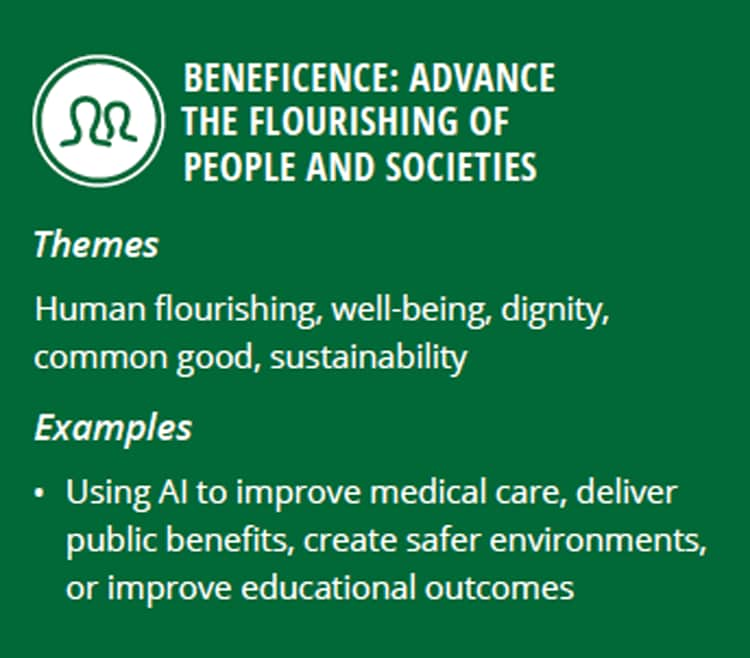
Knowing that machine learning algorithms perform reliably only to the extent that the data used to train them suitably represents the scenarios in which they are deployed, an organization can take steps to identify and mitigate the risks arising from this limitation. Some tactics might include:20
- Assessing the training data’s provenance—where the data arose, what inferences were drawn from the data, and how relevant those inferences are to the present situation—to assess an algorithm’s applicability.
- Restricting algorithms’ use to environments in which they are likely to be reliable. For example, autonomous vehicles could be restricted to special lanes that are off-limits to (unpredictable) human drivers, pedestrians, and animals.21 Similarly, a chatbot could be designed to avoid collecting personally identifiable information (PII), or to ignore certain words in order to lessen the risk of being gamed.22
- Coupling humans, who are capable of common-sense reasoning and flexible decision-making, with algorithmic systems. For example, a semiautonomous vehicle could use AI not to replace the human operator, but to help him or her drive more safely.23 Similarly, rather than replacing human experts (such as physicians, caseworkers, judges, claims adjusters, teachers grading student papers, or editors flagging unacceptable social media content), algorithms can be designed to help manage workloads and debias these experts’ decisions by providing statistically derived indications. In high-stakes scenarios, a pragmatic default might be to assume the need for human-computer collaboration, and treat full machine autonomy as a limiting case.24
AI’s common-sense gap
AI is best defined in functional terms as any kind of computer program capable of achieving a specific goal ordinarily associated with human intelligence.25 At one end of the spectrum, AI encompasses such rule-based systems as robotic process automation (RPA). At the other end, many of today’s headline-grabbing applications result essentially from large-scale statistical analysis: The application of supervised machine learning techniques to large data sets. One of these techniques in particular, known as “deep learning,” underlies many familiar AI applications, such as chatbots and the image recognition systems used to help pilot cars or flag tumors in X-rays.
When researchers first introduced the term “artificial intelligence” in the 1950s, the aspiration was to build computer systems that manifest human-level general intelligence. Today, however, “AI” has largely come to denote more focused, narrow applications that do not possess the flexibility of human thought. The old idea that “general” AI would mimic human cognition has given way to today’s multitude of practical, narrow AIs that operate very differently from the human mind.
Unlike human intelligence, AI algorithms do not possess common sense, conceptual understanding, notions of cause-and-effect, or intuitive physics. As an illustration, a human can use common sense and contextual awareness to learn a new bit of slang based on just a few encounters. A machine translation algorithm, in contrast, would need to be exposed to many pretranslated examples to hopefully get it right.26
Their lack of common sense, the inability to generalize or to consider context, makes AI algorithms “brittle,” meaning that they cannot handle unexpected scenarios or unfamiliar situations. As Gary Marcus and Ernest Davis comment in their book Rebooting AI:
Without a rich cognitive model, there can be no robustness. About all you have instead is a lot of data, accompanied by a hope that new things won’t be too different from those that have come before. But that hope is often misplaced, and when new things are different enough from what happened before, the system breaks down.27
Some commentators have suggested that the auto industry’s overly optimistic forecasts of the arrival of fully autonomous vehicles were likely influenced by the neglect of this fundamental point.28
AI for good
The principle of beneficence, reflected in many AI ethics declarations, holds that AI should be designed to help promote the well-being of people and the planet. In the book Tools and Weapons, Brad Smith used the term “inclusivity” to denote a similar idea, citing AI technologies created to help people overcome visual or hearing impairment. Beneficent AI applications can run the gamut of physical and emotional well-being, and operate at both individual and collective levels. Some examples are:
- An early application of affective computing (also called “emotional AI”) that aimed to help autistic people, who characteristically have difficulty inferring other’s emotional states, better navigate social situations.29 Such deep learning-based systems can often infer emotional states from facial expressions better than many humans, and thereby function as “emotional hearing aids” to help decipher others’ behavioral cues.
- “Data for good” initiatives that use AI algorithms to identify high-poverty areas by analyzing satellite imagery, flag houses that pose a high risk of lead poisoning to their residents, recognize which high school students are at risk of not graduating on time, or identify police officers at greater risk of experiencing adverse events.30
- Chatbots that deliver cognitive behavioral therapy interventions to help ameliorate conditions such as low-level depression and anxiety.31
- Social robots that incorporate “growth mindset” interventions to help children stay focused in learning environments.32
- Wearables paired with gamification or other behavioral “nudge” interventions designed to prompt healthier behaviors.33
- Data-rich apps, again infused with behavioral nudge design, designed to help gig workers save small amounts of money each day to better achieve their financial goals.34
Interestingly, while non-maleficence was the third-most common principle in the AI ethics declarations studied by the ETH Zurich team, the principle of beneficence appeared in less than half of them. It is possible that this disparity reflects a prevalence of alarmist discussions of AI that focus more on harm, but dwell less on AI’s potential to help debias human decisions, extend human capabilities, and improve well-being.
Managing tradeoffs
Ethical deliberations often involve managing tradeoffs between different principles that cannot be simultaneously satisfied. Tradeoffs between beneficence and non-maleficence are common. For example, the public might be willing to accept a certain fatality rate associated with autonomous vehicles if it is lower than the fatality rate resulting from humans operating more traditional vehicles.
Sometimes, the process of articulating an ethical tradeoff can spur innovations that render the tradeoff less fraught. One government agency, for instance, commissioned a machine learning algorithm to identify people at relatively high likelihood of improperly collecting unemployment insurance (UI) benefits. For unavoidable technical reasons, any such algorithm could have yielded a large number of false positives—mistakenly flagging legitimate claims as improper.35 If the agency had simply used the algorithm to feed an automatic decision rule of the form “If the score exceeds x, deny benefits,” the inevitable false positives would have led the agency to deny needed UI benefits to large numbers of deserving people.
For this reason, the data science team instead designed the AI system to function as a “nudge engine.” Instead of denying benefits to high-scoring individuals, the agency delivered well-timed behavioral “nudge” pop-up messages—such as “nine out of 10 of your neighbors in [your county] report their earnings accurately”—to claimants the algorithm flagged as suspicious. These messages did no harm to individuals inaccurately flagged by the algorithm, but they had the desired effect among people who were in fact improperly claiming benefits. Randomized controlled trials of the system revealed that the machine learning-targeted nudge messages cut improper UI payments by approximately 50 percent.36
The broader point is that ethical AI requires organizations to consider not only predictions, but interventions as well.37 Often, “classical economic” interventions such as setting prices, offering or withholding treatment, and delivering punishments or rewards are the only ones considered. The newer science of choice architecture expands the toolkit with “soft” interventions that can allow organizations to act ethically on ambiguous algorithmic indications.38 In cases where nudge interventions aren’t strong enough, ethical deliberation should help guide policy decisions about how machine-generated predictions are acted upon. For example, a certain predictive algorithm could be deployed either to deny benefits or provide proactive outreach to help at-risk cases.
A still broader point is that technological innovation, often involving multidisciplinary thinking, can also make it possible to mitigate difficult ethical tradeoffs. The increasingly popular tagline “human-centered AI” can perhaps be interpreted as a call to take human and societal needs into account when developing uses for AI technologies.39
Justice: Treating people fairly
Justice is another core ethical principle that appears frequently in AI ethics declarations.40 In the ETH Zurich analysis, it encompasses such related concepts as inclusion, equality, diversity, reversibility, redress, challenge, access and distribution, shared benefits, and shared prosperity.
Much of the conversation about justice as it relates to AI revolves around “algorithmic fairness”—the idea that AI algorithms should be fair, unbiased, and treat people equally. But what does it mean for an algorithm to be “fair”?
It is useful to distinguish between the concepts of procedural and distributive fairness. A policy (or an algorithm) is said to be procedurally fair if it is fair independently of the outcomes it produces. Procedural fairness is related to the legal concept of due process. A policy (or an algorithm) is said to be distributively fair if it produces fair outcomes. Most ethicists take a distributive view of justice, whereas a procedure’s fairness rests largely on the outcomes it produces. On the other hand, studies by social psychologists and behavioral economists have shown that people often tend toward a more procedural view, in some cases caring more about being treated fairly than the outcomes they experience.41
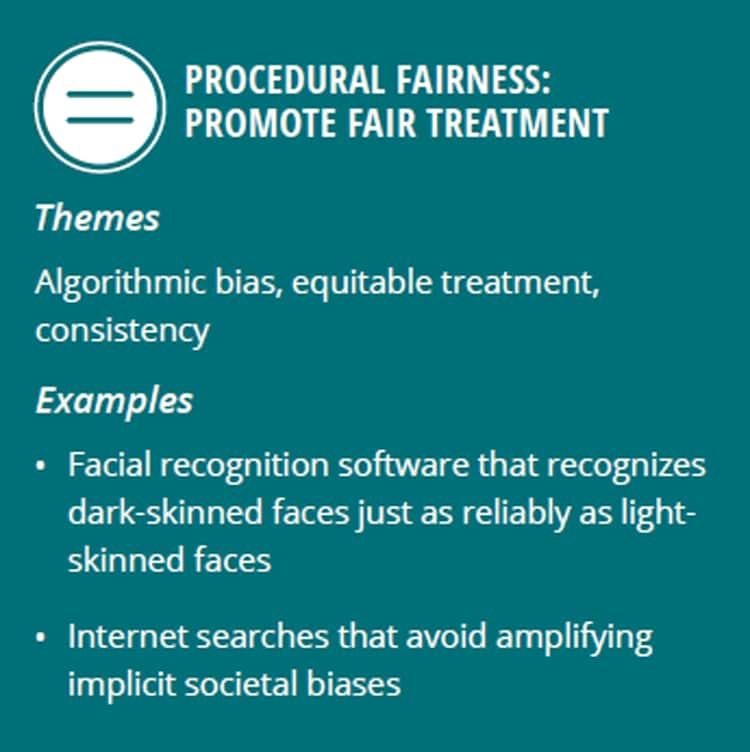
While AI algorithms often attract criticism for being distributively unfair, many such discussions implicitly invoke procedural fairness as well. For example, some critics believe that giving female names and voices to digital assistants can reinforce societal biases.42 Common examples point to cases where societal biases are reflected in the data sets used to train algorithms:43 Searches for “CEO” may yield disproportionate images of white men,44 and facial recognition systems have been shown to be less accurate when identifying individuals with darker skin.45
Clearly, the outputs of algorithms like these can be distributively unfair in that they could encourage biased outcomes: white males securing a disproportionate number of high-paying jobs, or higher autonomous vehicle accident rates among dark-skinned pedestrians due to the software’s poorer performance in recognizing darker-skinned individuals.46 But even setting outcomes aside, such algorithms may impact many people’s sense of procedural fairness. For example, webcams that struggle to recognize dark-skinned faces, or internet searches for “CEO” that yield primarily male faces,47 might be considered inherently objectionable regardless of the impacts on functionality or career progression.

Addressing such issues typically requires that the statistical methodologies used to create algorithmic systems incorporate appropriate ethical deliberation. Recall the point made above that machine learning algorithms are reliable only to the extent that they are trained on suitable data sets. For many applications, it is desirable to train an algorithm on data that reflects the way the world is. To accurately forecast sales, for instance, an algorithm must work with data that is representative of the population of likely customers. But what if faithfully representing the world as it is means possibly perpetuating an unfair state of affairs? In such situations, the desire for fairness may motivate the construction of training samples that reflect judgments about the way the world ought to be—an ethically influenced choice.
Just as data science should incorporate ethical deliberation, so should ethical deliberation be informed by careful data science. A spate of important research was prompted by a 2016 ProPublica investigation that revealed that a widely used recidivism algorithm had a much higher false positive rate for Black people than white people.48 Intuitively, this difference might seem blatantly unacceptable. But if (1) the overall recidivism base rate is higher for Black people than for white people and (2) the algorithm manifests “predictive parity” in the sense that a high score means approximately the same probability of reoffending, the higher misclassification rate for Black people is a mathematical inevitability.
This result is representative of a growing body of research pointing to mathematically inevitable tradeoffs in different conceptions of algorithmic “fairness.”49 An emergent theme is that, as with impact, assessing the “fairness” of an algorithm will often involve evaluating tradeoffs rather than making a binary determination.
A further point is that discussions of algorithmic fairness should reflect not only the shortcomings of machine predictions, but the shortcomings of human decisions as well. The behavioral economist Sendhil Mullainathan points out that the applications in which people worry most about algorithmic bias are also the very situations in which algorithms—if properly constructed and implemented—also have the greatest potential to reduce the effects of implicit human biases.50
For example, hiring is a realm notorious for its susceptibility to cognitive unconscious biases that may affect who eventually gets the job. A well-known field study in the United States, co-led by Mullainathan, demonstrated that simulated resumes with Black-sounding names attracted significantly fewer interviews than comparable resumes with white-sounding names.51 In contrast, Michael Lewis’s Moneyball illustrates that properly constructed algorithms can outperform unaided human intuitions in predicting who is most likely to succeed on the job.52
Naïvely training machine learning algorithms on “convenience samples” of data can quite possibly encode and reinforce human biases reflected in the data. At the same time, Mullainathan’s point implies that simply avoiding algorithms altogether can also be ethically problematic. Unlike human decisions, machine predictions are consistent over time, and the statistical assumptions and ethical judgments used in algorithm design can be clearly documented. Machine predictions can therefore be systematically audited, debated, and improved in ways that human decisions cannot.53
Autonomy: Respecting humanity and self-determination
Put simply, autonomy is the ability of people to make their own decisions. The Stanford Encyclopedia of Philosophy provides a somewhat more expansive definition:
Autonomy is … the capacity to be one's own person, to live one's life according to reasons and motives that are taken as one's own and not the product of manipulative or distorting external force.54
Many of the principles discussed in the various AI ethics declarations, such as transparency, explainability, privacy, and dignity, can be viewed as aspects of respect for autonomy.55
In bioethical contexts, the autonomy principle is often invoked in the context of people’s freedom to choose whether to receive medical treatments or participate in medical studies. Its applicability to AI is perhaps equally obvious. When humans employ autonomous systems, they cede, at least provisionally, some of their own autonomy (decision-making power) to machines. However, autonomous systems can provide human users with clues about when it is appropriate to cede some of their autonomy, and also give the ability to override the system at appropriate points.56
Handing over some portion of one’s autonomy to an intelligent machine need not pose an ethical problem. In fact, doing so can sometimes be the more ethical choice. For example, the use of diagnostic decision trees (a common type of statistically derived AI algorithm) in emergency rooms can improve the accuracy of triage decisions for patients suffering chest pain. The algorithm is good at a specific kind of task that humans are generally poor at: combining risk factors in consistent and unbiased ways. In one sense, a physician who uses the algorithm gives up part of his or her autonomy—but in a deeper sense, the algorithm can actually enhance the physician’s autonomy, acting as a kind of cognitive prosthesis or assistant that can help the physician achieve the goal of better treating the patient.
Autonomy does not require explainability
The medical decision tree is an example of what is increasingly called “explainable AI”—AI tools whose processes and indications are understandable, in varying degrees, by human users. Though typically less accurate than more complex algorithms, decision tree models are sometimes preferred in medical contexts because of their relative transparency and intuitive nature.57 Explainability can be viewed through the lens of promoting human autonomy: If a diagnostic algorithm is easy to understand, a physician can make an informed judgment about when it is appropriate to let the algorithm guide the decision. Greater comprehension allows for more informed decision-making and the ability to choose.
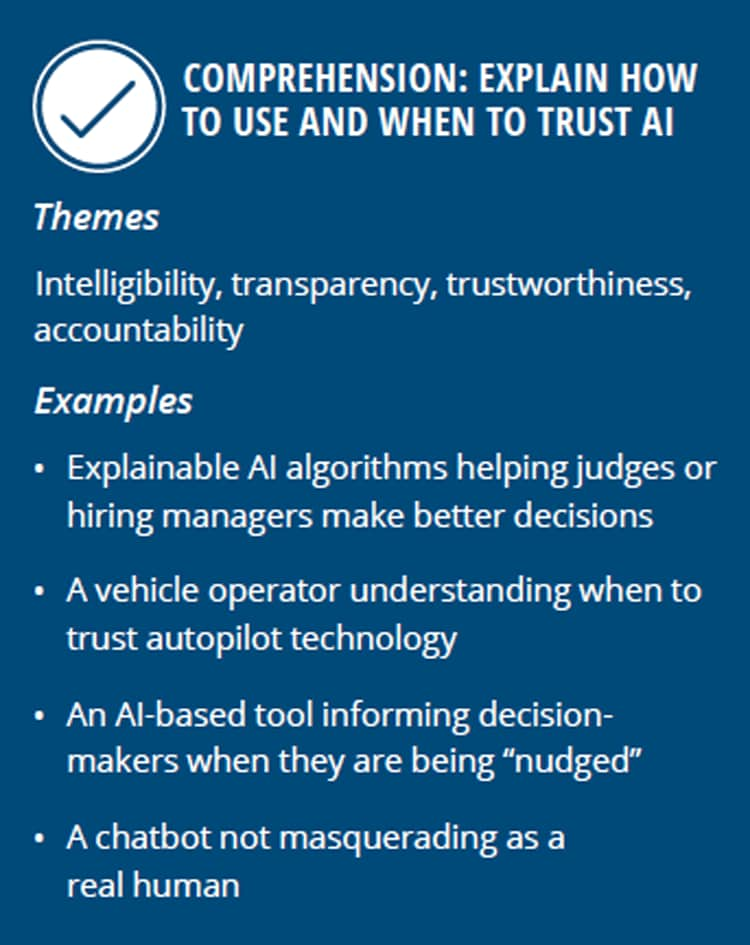
Unfortunately, many forms of AI, such as medical decision algorithms derived from deep learning or the algorithms used to pilot semiautonomous vehicles, do not afford similar transparency or interpretability. Providing “why” explanations to accompany black-box predictive algorithms is an ongoing area of research.58 But today’s state of the art is such that full explainability is not always a realistic goal. Yet this need not raise an ethical red flag: Explainability might not always be necessary or even desirable. In such low-stakes scenarios as product recommendations, there may be little demand for the explanations behind specific algorithmic outputs. And in high-stakes scenarios, the additional accuracy provided by complex algorithms might trump the desire for transparency and explainability. This is yet another example of an ethical tradeoff that should be deliberated.
In scenarios involving highly complex algorithms, the concept of trustworthiness might be a more useful organizing principle than explainability.59 For example, few drivers or airline pilots fully understand the inner workings of their semiautonomous vehicles. But through a combination of training, assurances provided by safety regulation, the manufacturer’s reputation for safety, and tacit knowledge acquired from using their vehicles, the user develops a working sense of the conditions under which the vehicles can be trusted to help them achieve their goal of safely getting from point A to point B. It is notable that recent examples of semiautonomous vehicle crashes have resulted from unwarranted levels of trust placed in driver assistance systems.60 To reduce the risk of accidents, what is needed is not full explainability but rather a working sense of the conditions under which the algorithmic system should and should not be trusted.
Nudging in the service of autonomy
Most discussions of AI’s impact on human autonomy focus on the type of deliberative decision-making that the cognitive scientist Daniel Kahneman calls “System 2” or “thinking slow”:61 diagnosing a patient, hiring a worker, releasing a defendant on bail. But AI technologies can also affect more reflexive “System 1” or “thinking fast” decision-making. For example, people are disproportionately likely to choose the default option, the option described in the most intuitive language, the option that comes up first in the search engine, or the option they believe similar people tend to make. Because of such innate tendencies, what Richard Thaler and Cass Sunstein call “choice architecture”—or “nudging”—can significantly influence people’s decision-making.
For example, recall the state agency that, in using an AI algorithm to flag potentially fraudulent UI claims, chose to selectively “nudge” claimants toward honest behavior rather than selectively cut off benefits based on the algorithm’s output. This use of behavioral nudges allowed the agency to avoid the unintentional maleficence of denying needed benefits to legitimate claimants. But nudging can also have implications for autonomy. For example, nudge interventions shouldn’t mislead with false information or otherwise manipulate people to act in ways that go against their self-interest.62 Recall the ethical imperative to avoid “manipulative or distorting external forces.”
Commentators increasingly warn of the autonomy-threatening potential of AI technologies infused with behavioral design. In a recent Scientific American editorial, a distinguished group of scientists commented:
Some software platforms are moving towards “persuasive computing.” In the future, using sophisticated manipulation technologies, these platforms will be able to steer us through entire courses of action, be it for the execution of complex work processes or to generate free content for internet platforms, from which corporations earn billions. The trend goes from programming computers to programming people … The magic phrase is “big nudging,” which is the combination of big data with nudging.63
The overarching—and legitimate—fear is that AI technologies can be combined with behavioral interventions to manipulate people in ways designed to promote others’ goals. Examples include, behavioral algorithms coupled with persuasive messaging designed to prompt individuals to choose products, political candidates, privacy settings, data-sharing agreements, or gig work offers that they might not choose if they had better self-control or access to better information.
However, the flip side is that nudging ethically carried out can often enhance rather than diminish human autonomy. For example, AI algorithms can customize and target behavioral interventions that, when embedded in data-rich, digital environments, can make it easier for people to save more for retirement, engage in healthier behaviors, drive more safely, and more effectively manage time and collaborate on the job.64 Just as a medical decision tree enhances physicians’ autonomy by enabling better deliberative decisions, so too can effective choice architecture enable boundedly rational individuals to better achieve their goals through improved reflexive or habitual decisions. In each case, the AI is autonomy-enhancing.
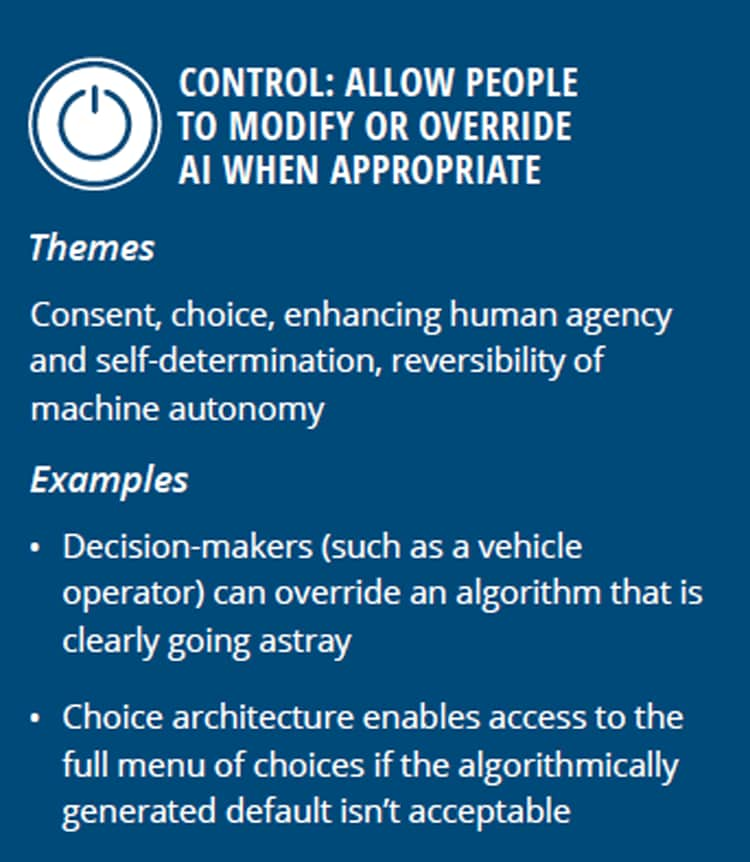
Furthermore, the choice architecture pioneer Cass Sunstein points out that in many situations, denying people the benefits of smart choice architecture can in fact undermine their autonomy. For example, when tasked with navigating a complex set of health or employee benefit choices, an algorithm might be used to highlight an appropriate default choice (with the full menu of choices a click away). Avoiding such choice architecture might force the individual to spend a great deal more time researching and deliberating this decision, potentially impairing his or her ability to pursue other goals that he or she deems more important. In such a case, Sunstein would say that people should be given the option to “choose not to choose.”65
The central issue in these considerations appears to be control. Respecting individual autonomy requires that people have the freedom to make their own choices—including, paradoxically, the freedom to choose to be “nudged” or guided in ways that they believe enhance their well-being.
Once again, the concept of trustworthiness is paramount. When presenting people with a deliberately designed choice architecture, it is incumbent upon the architect to communicate to users that they are, in fact, being nudged, to give them the ability to opt out (in this case, see the full menu of choices); and, most importantly, cultivate their trust that the choice architect has designed the choice environment in ways that help them achieve their goals.
Ethical AI by design
Ethics is often viewed as a constraint on organizations’ abilities to maximize shareholder returns. But we suggest a different perspective: that ethical principles can serve as design criteria for developing innovative uses of AI that can improve well-being, reduce inequities, and help individuals better achieve their goals. In this sense, the principles of impact, justice, and autonomy can help shape AI technologies in ways that achieve what marketing, management, and design professionals, respectively, call customer-centricity, employee-centricity, and human-centricity. Developing trustworthy AI technologies that safely and fairly help advance these goals is a distinctly 21st-century way for organizations to do well by doing good.
© 2021. See Terms of Use for more information.
Explore the issue
-
A new mindset for public sector leadership Article5 years ago
-
The makings of a more confident CMO Article5 years ago
-
Technologies that touch you Article5 years ago
-
The digital-ready worker Article5 years ago














